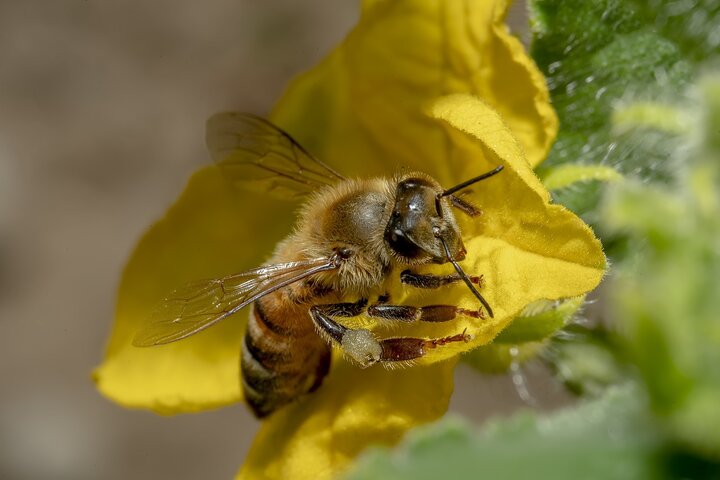Sarah Browning, Extension Educator

Tomato spotted wilt virus symptoms on a pepper plant. Image from Gerald Holmes, Strawberry Center, Cal Poly San Luis Obispo, Bugwood.org.
It’s so disappointing to reach mid-summer, having nurtured a vegetable for several months, only to find disease problems starting to appear!
The first step toward control should always be disease identification. Gardeners can submit pictures of plant problems to Nebraska Extension experts through our Digital Diagnostic Network, http://digitaldiagnostics.unl.edu/. An expert panel of Extension professionals will promptly review and respond to your question.
Cultural Control
Leaf spot diseases - like tomato early blight, cucurbit downy mildew and many more - are some of the most common vegetable garden problems. Once plants are infected,

- Leaf spot infections may be slowed by removing diseased leaves. Start as soon as symptoms appear.
- Keep plants as dry as possible when watering. Leaf wetness promotes infection and its spread.
- Trellis plants to improve air movement through the foliage and keep fruits up off the ground. Improving air flow promotes faster leaf drying after rain, dew or irrigation.
- Mulch soil beneath plants to prevent rain splash of additional fungal spores from the soil onto plant lower leaves.
- Remove and discard infected fruits. Remove heavily diseased plants completely.
Viruses and wilt diseases, such as tomato spotted wilt virus, cucumber mosaic virus and Verticillium wilt, cannot be controlled once plants are infected. Remove and discard infected plants as soon as possible to prevent these problems from spreading.
For more information on diagnosing vegetable diseases, including pictures and specific control recommendations for each, visit Disease Management for Vegetable Crops. https://extension.umn.edu/vegetables/disease-management
Using Fungicides
Once the disease has been identified, gardeners could choose to use a fungicide to slow disease development. Fungicides are protective; they are not curative, which means infected foliage will remain diseased and may die.
Fungicides must be applied on a regular schedule - 7, 10 or 14 day intervals are common - to provide continued protection for new growth, healthy leaves and fruits. Follow label directions on reapplication timing and the total number of applications allowed per year.
Always make sure any product purchased is labeled for use in the vegetable garden and follow all directions on waiting periods after application before harvesting again.
Below are common home garden fungicides, readily available at garden centers. While they are less damaging to pollinators and beneficial insects than other garden pesticides, that does not mean no damage.
No known impact on bees:

- Bacillus amyloliquifaciens - contact control. Prevents infections through formation of antimicrobials and competitive exclusion. Monterey Complete Disease Control
- Bicarbonates - contact control. Potassium bicarbonate (GreenCure, Kaligreen, Bi-Carb, Remedy) or ammonium bicarbonate products provide the best disease control.
- Mancozeb - contact control. Broad spectrum product active against many different diseases. Bonide, Mancozeb, Flowable
Bee mortality with exposure. Avoid applying when bees are present:
- Copper fungicide – contact control. Provides protection against infection by killing disease pathogens on a leaf or other surface before they infect the plant. Must be applied preventatively. Has no post-infection action. Many formulations of copper fungicides are available, including Captain Jack Copper Fungicide, Bonide Copper Fungicide, or Liquid Copper. Follow label directions to prevent foliage burn or phytotoxic reactions.
- Sulfur- contact control. Finely ground dust or liquid sulfur can be used either as a dust or spray to prevent diseases, by stopping fungal spores from germinating. The chemical may ‘burn’ tender foliage if air temperature is 90 degrees F or higher when it is applied. Do not apply within 20-30 days of applying a horticultural oil since plant damage may result. BioAdvanced Fruit & Vegetable 3-in-1 Solution, Bonide Liquid Sulfur, Bonide Sulfur Plant Fungicide
Causes mortality to bee larvae when exposed by foraging adults:
- Chlorothalonil - contact control. Protects against a wide range of vegetable garden diseases. Daconil, Fung-oil
Causes damage to bees when mixed with other fungicides. Avoid applying tank mixtures with other products during the vegetable bloom period:
- Chlorothalonil
- Myclobutanil - systemic control. Can be used on asparagus, cucurbits, snap bean and tomato. Protects up to 2 weeks. Number of applications allowed per year vary by crop. Monterey Fungi Max, Spectracide, Immunox
As with any pesticide used in the garden or landscape, always read and follow all label directions and precautions, including the use of personal protective equipment.
Note: Reference to commercial products or trade names is made with the understanding that no discrimination is intended. These products are listed as examples only. No endorsement by the University of Nebraska-Lincoln or Nebraska Extension is implied.
Images
- Tomato early blight, Alternaria solani, can be identified by concentric rings which form in the leave lesions. Image from Gerald Holmes, Strawberry Center, Cal Poly San Luis Obispo, Bugwood.org.
- Even though they are not insecticides, fungicides can damage bees. Avoid applying to flowers when bees are present. Image from Pixabay.com.
Search Our Archive
Associated Video
Leaf Spots
Nebraska Extension Plant Diagnostician Kyle Broderick takes a look at different leaf spots and helps you identify what is spotting your plant. Jul 3, 2020